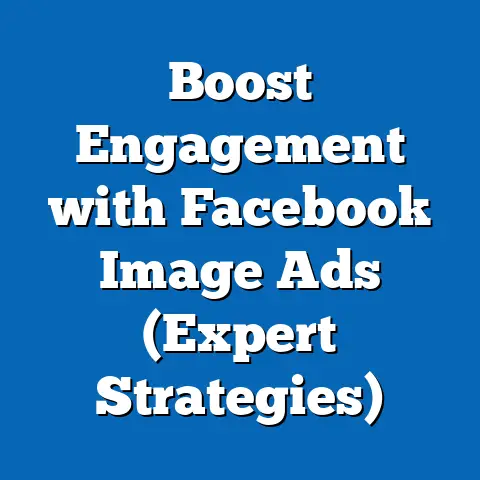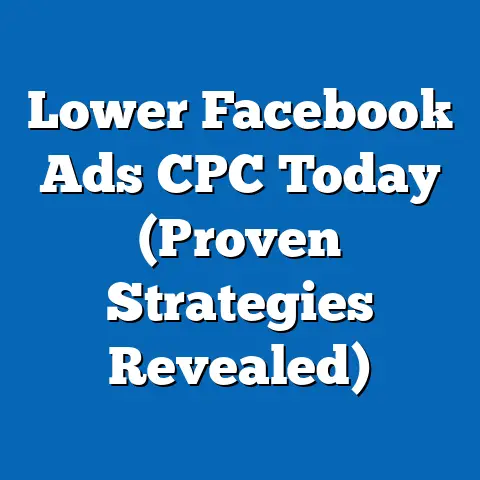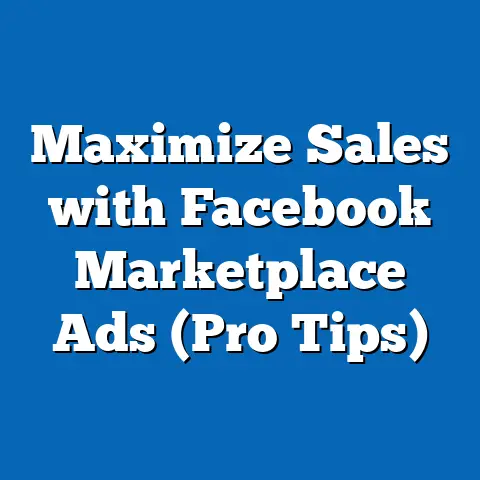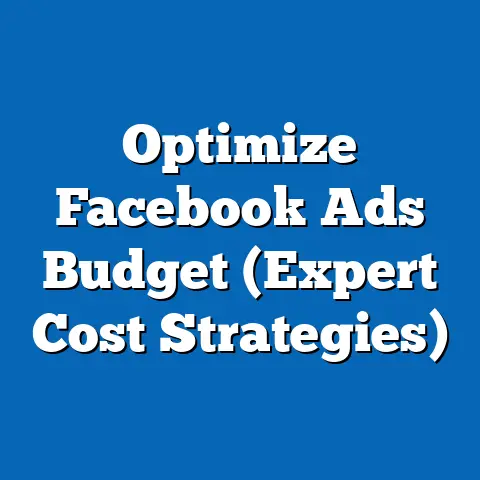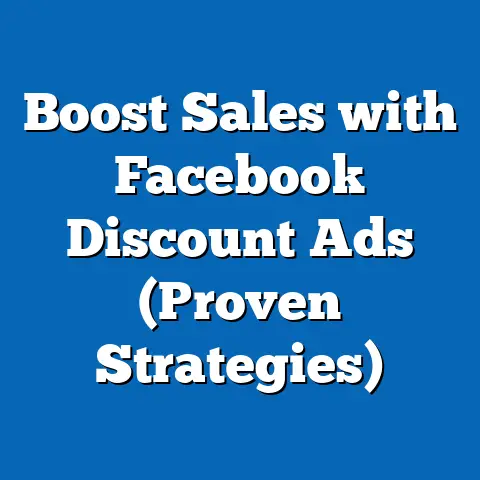Maximize Facebook Carousel Ads (Proven Strategies)
Many marketers believe that static images are the bread and butter of eye-catching Facebook ads. This couldn’t be further from the truth! I’ve seen firsthand how leveraging carousel ads can significantly enhance engagement and drive conversions, often blowing static images out of the water.
Understanding Facebook Carousel Ads
Let’s start with the basics. What exactly are Facebook Carousel Ads? Essentially, they’re an ad format on Facebook and Instagram that allows you to showcase up to ten images or videos within a single ad unit. Users can swipe through these cards, each with its own headline, description, and link.
I remember when carousel ads first rolled out. Many marketers, including myself, were hesitant. “Another new format to learn?” we groaned. But once I started experimenting, I quickly realized their power. They’re not just about showing more; they’re about engaging users in a more interactive way.
Here’s a breakdown of the key components:
- Number of Cards: You can include between two and ten cards in a carousel ad. This gives you ample space to tell a story or showcase a range of products.
- Swipe Feature: The swipeable nature of the format is crucial. It encourages users to actively engage with your ad, increasing the chances of them remembering your message.
- Content Types: You can use images, videos, or a combination of both. This flexibility allows you to tailor your content to your specific goals and audience.
- Individual Links: Each card can have its own unique link, allowing you to direct users to different pages on your website or specific product listings.
Why are carousel ads so effective?
Statistics don’t lie. Studies have consistently shown that carousel ads outperform other ad formats in several key areas. For example:
- Higher Click-Through Rates (CTR): I’ve personally seen carousel ads generate CTRs that are significantly higher than single-image ads. In one campaign for a local bakery, our CTR jumped by over 50% when we switched from a static image ad to a carousel showcasing their different pastries.
- Increased Engagement: The interactive nature of carousel ads encourages users to spend more time engaging with your brand.
- Improved Conversion Rates: By showcasing multiple products or features, carousel ads can guide users through the sales funnel more effectively, leading to higher conversion rates.
Take, for example, a case study from clothing retailer ASOS. They used carousel ads to showcase different outfits from their latest collection. By allowing users to swipe through the looks and click directly on the items they liked, they saw a significant increase in sales and website traffic. This is the power of a well-executed carousel ad!
Takeaway: Carousel ads are a versatile and effective ad format that can significantly boost your Facebook advertising performance. Understanding their functionality and benefits is the first step towards creating compelling campaigns.
The Psychology Behind Carousel Ads
Beyond the technical aspects, understanding the psychology behind why carousel ads work is crucial for creating truly effective campaigns. It’s not just about showing more; it’s about tapping into the way people think and behave online.
One of the most powerful psychological principles at play is curiosity. When users see a carousel ad, they’re immediately intrigued. What’s on the next card? This curiosity encourages them to swipe and explore, increasing their engagement with your brand.
I’ve noticed this firsthand. Think about it – when you see a stack of pancakes, don’t you want to see the entire stack? It’s the same with carousel ads; they create a sense of anticipation and encourage users to discover what’s next.
Storytelling is another key element. Carousel ads provide a unique opportunity to tell a story, guiding users through a narrative that resonates with them on an emotional level. Each card can contribute to the overall story, building intrigue and leading users towards a desired action.
For instance, a travel company could use a carousel ad to tell the story of a dream vacation. The first card could show a stunning landscape, the second could highlight local cuisine, and the third could showcase exciting activities. By weaving a cohesive narrative, they can capture users’ imaginations and inspire them to book their own adventure.
Visual hierarchy is also critical. The way you arrange the elements within each card can significantly impact how users perceive your message. Consider the placement of your headline, description, and call-to-action. Use visual cues like arrows or contrasting colors to guide users’ eyes and draw their attention to the most important information.
I always think of it like this: you’re directing a movie. You want to control where the viewer looks and what they focus on. In a carousel ad, you’re the director, and each card is a scene. Use visual hierarchy to guide the user’s eye and ensure they understand your message.
How does the interactive nature of carousel ads capture attention?
In a world of endless scrolling, anything that breaks the monotony is a win. Carousel ads do just that. The swipeable format is inherently engaging, requiring users to actively participate in the experience. This active engagement increases the likelihood that they’ll remember your brand and message.
Takeaway: By understanding the psychological principles that make carousel ads effective, you can create campaigns that are not only visually appealing but also deeply engaging and persuasive. Tap into curiosity, tell compelling stories, and use visual hierarchy to guide users towards your desired outcome.
Proven Strategies to Maximize Facebook Carousel Ads
Now, let’s dive into the actionable strategies you can use to maximize the impact of your Facebook carousel ads. These are the techniques I’ve personally used and refined over years of running successful Facebook campaigns.
Strategy 1: Crafting Compelling Visuals
Visuals are the heart and soul of any Facebook ad, and carousel ads are no exception. High-quality images and videos are essential for capturing attention and conveying your message effectively.
Why is quality so important?
Think about it from the user’s perspective. They’re scrolling through their feed, bombarded with content. If your visuals are blurry, pixelated, or poorly composed, they’ll simply scroll past. You have a fraction of a second to make an impression, so make it count.
Tips for choosing the right visuals:
- Align with your branding: Your visuals should be consistent with your brand’s overall aesthetic. Use the same colors, fonts, and imagery to create a cohesive look and feel.
- Highlight your product’s best features: Showcase your product from different angles, highlighting its key features and benefits.
- Use lifestyle images: Show your product in action, being used by real people in real-life scenarios. This helps users visualize themselves using your product and makes it more relatable.
- Optimize for mobile: Remember that most Facebook users are on mobile devices. Make sure your visuals are optimized for smaller screens and load quickly.
The importance of consistency across carousel cards:
Each card in your carousel ad should feel like it belongs to the same family. Use a consistent color palette, font, and overall design to create a cohesive experience. This helps users understand that all the cards are related and encourages them to swipe through the entire ad.
Example:
I recently worked with a fitness studio that was struggling to attract new clients. We created a carousel ad showcasing different classes they offered. Each card featured a high-quality image of people enjoying the class, along with a brief description and a call-to-action to sign up for a free trial. The visuals were consistent across all the cards, using the studio’s signature colors and fonts. The result? A significant increase in sign-ups and website traffic.
Takeaway: Invest in high-quality visuals that align with your branding and highlight your product’s best features. Ensure consistency across all the cards in your carousel ad to create a cohesive and engaging experience.
Strategy 2: Creating a Cohesive Story
Carousel ads offer a unique opportunity to tell a story, guiding users through a narrative that resonates with them on an emotional level. Don’t just throw a bunch of random images together. Think about how you can use each card to build intrigue and lead users towards your desired action.
How should each card tell a part of a larger narrative?
Think of your carousel ad as a mini-movie. Each card is a scene, and together they tell a complete story. Start with an attention-grabbing opening, build suspense in the middle, and end with a compelling call-to-action.
Examples of brands that have successfully used storytelling:
- Airbnb: They often use carousel ads to showcase different types of accommodations in a specific destination. Each card features a stunning image of the property, along with a brief description and a link to book. By telling the story of a unique travel experience, they inspire users to book their own adventure.
- GoPro: They use carousel ads to showcase action-packed videos and images captured with their cameras. Each card features a different scene, highlighting the versatility and capabilities of their products. By telling the story of adventure and excitement, they inspire users to capture their own experiences with GoPro.
Tips on how to structure the story for maximum emotional impact:
- Start with a problem: Identify a pain point that your target audience is experiencing.
- Introduce your product as the solution: Show how your product can solve their problem and make their lives easier.
- Highlight the benefits: Focus on the positive outcomes of using your product.
- End with a call-to-action: Tell users exactly what you want them to do next.
Example:
I worked with a local bookstore that was struggling to compete with online retailers. We created a carousel ad that told the story of a reader discovering a new favorite book. The first card showed a person feeling bored and uninspired. The second card showed them browsing the shelves of the bookstore. The third card showed them engrossed in a book, completely captivated. The final card featured a call-to-action to visit the bookstore and discover their next favorite read. This storytelling approach resonated with users and drove a significant increase in foot traffic.
Takeaway: Don’t just show products; tell stories. Use each card in your carousel ad to build intrigue and lead users towards a desired action. Structure your story for maximum emotional impact, starting with a problem and ending with a solution.
Strategy 3: Utilizing Call-to-Actions Effectively
A call-to-action (CTA) is the most important element of any ad. It tells users exactly what you want them to do next. Without a clear and compelling CTA, your ad is simply a pretty picture with no purpose.
The role of clear and compelling CTAs in driving user action:
Your CTA should be clear, concise, and action-oriented. Use strong verbs like “Shop Now,” “Learn More,” “Sign Up,” or “Get Started.” Make it easy for users to understand what you want them to do and why they should do it.
Examples of effective CTAs that can be used on carousel ads:
- Shop Now: Ideal for e-commerce businesses looking to drive sales.
- Learn More: Great for generating leads or providing more information about your product or service.
- Sign Up: Perfect for building your email list or getting users to register for a webinar or event.
- Get Started: Useful for encouraging users to try your product or service for free.
- Contact Us: Effective for generating inquiries or providing customer support.
The importance of placing CTAs strategically within the carousel:
Don’t just slap a CTA on the last card. Think about where it makes the most sense within the context of your story. Sometimes it’s best to place a CTA on every card, especially if you’re showcasing multiple products. Other times, it’s more effective to save the CTA for the final card, after you’ve built intrigue and established the value of your offering.
Example:
I recently worked with a software company that was launching a new product. We created a carousel ad showcasing the different features of the product. Each card featured a screenshot of the software, along with a brief description and a call-to-action to “Learn More.” By placing a CTA on every card, we made it easy for users to explore the different features and learn more about the product. This led to a significant increase in website traffic and demo requests.
Takeaway: Your CTA is the key to driving user action. Make it clear, concise, and action-oriented. Place it strategically within your carousel ad to maximize its impact.
Strategy 4: A/B Testing Carousel Ads
A/B testing, also known as split testing, is the process of comparing two versions of an ad to see which one performs better. It’s an essential part of any successful Facebook advertising strategy.
Why is testing so important?
You can’t just guess what’s going to work. You need to test different visuals, copy, and CTAs to see what resonates with your target audience. A/B testing allows you to make data-driven decisions, rather than relying on gut feelings.
A step-by-step guide on how to set up A/B tests for carousel ads:
- Define your goal: What do you want to achieve with your A/B test? Are you trying to increase click-through rates, conversion rates, or engagement?
- Choose your variable: What element of your ad do you want to test? This could be the headline, the image, the description, or the CTA.
- Create two versions of your ad: Change only the variable you’re testing. Keep everything else the same.
- Set up your A/B test in Facebook Ads Manager: Use the “Split Test” feature to create two versions of your ad and allocate your budget evenly between them.
- Run your test for a sufficient amount of time: Allow enough time for your test to gather statistically significant data.
- Analyze the results: Compare the performance of the two versions of your ad and see which one performed better.
- Implement the winning version: Use the winning version of your ad in your ongoing campaigns.
Insights on interpreting the results to refine and optimize future ads:
Don’t just focus on the overall results. Look at the individual metrics to see why one version performed better than the other. Did it have a higher click-through rate? Did it generate more conversions? Understanding the reasons behind the results will help you refine and optimize your future ads.
Example:
I recently ran an A/B test for a local restaurant. We tested two different headlines for our carousel ad: “Best Pizza in Town” vs. “Authentic Italian Pizza.” The “Authentic Italian Pizza” headline performed significantly better, generating a higher click-through rate and more website traffic. This told us that our target audience was more interested in authenticity than simply the best pizza.
Takeaway: A/B testing is essential for optimizing your carousel ads and maximizing your return on investment. Test different visuals, copy, and CTAs to see what resonates with your target audience. Analyze the results and use the insights to refine and optimize your future ads.
Strategy 5: Targeting the Right Audience
Even the most visually stunning and compelling carousel ad will fall flat if it’s shown to the wrong audience. Targeting the right people is crucial for maximizing the impact of your campaigns.
The importance of audience segmentation and targeting:
Don’t just target everyone. Identify your ideal customer and create a specific audience based on their demographics, interests, and behaviors. This will ensure that your ad is seen by people who are most likely to be interested in your product or service.
How to leverage Facebook’s audience insights and targeting tools:
- Demographics: Target users based on their age, gender, location, education, and job title.
- Interests: Target users based on their interests and hobbies.
- Behaviors: Target users based on their online behavior, such as their purchase history or their engagement with specific websites or apps.
- Custom Audiences: Upload your own customer data, such as email addresses or phone numbers, to create custom audiences.
- Lookalike Audiences: Create lookalike audiences based on your existing customers. This allows you to target people who are similar to your best customers.
Case studies of successful targeting strategies used in carousel ads:
- A clothing retailer used custom audiences to target their existing customers with carousel ads showcasing new arrivals. This resulted in a significant increase in repeat purchases.
- A travel company used lookalike audiences to target people who were similar to their existing customers who had booked a vacation in the past. This led to a significant increase in bookings.
Example:
I worked with a local pet store that was struggling to attract new customers. We used Facebook’s targeting tools to target people who were interested in pets, lived within a 5-mile radius of the store, and had recently purchased pet supplies online. We created a carousel ad showcasing the store’s wide selection of pet food, toys, and accessories. This targeted approach resulted in a significant increase in foot traffic and sales.
Takeaway: Targeting the right audience is crucial for maximizing the impact of your carousel ads. Use Facebook’s audience insights and targeting tools to reach the people who are most likely to be interested in your product or service.
Measuring Success and Optimization
You’ve created compelling carousel ads, targeted the right audience, and now it’s time to measure your success and optimize your campaigns for even better results. Data is your best friend in the world of Facebook advertising.
Key performance indicators (KPIs) to track:
- Click-Through Rate (CTR): This measures the percentage of people who saw your ad and clicked on it. A high CTR indicates that your ad is relevant and engaging.
- Conversion Rate: This measures the percentage of people who clicked on your ad and completed a desired action, such as making a purchase or filling out a form. A high conversion rate indicates that your ad is effective at driving results.
- Cost Per Click (CPC): This measures the cost of each click on your ad. A low CPC indicates that your ad is efficient and cost-effective.
- Cost Per Conversion (CPC): This measures the cost of each conversion. A low CPA indicates that your ad is generating leads or sales at a reasonable cost.
- Engagement Metrics: Track metrics like likes, comments, and shares to see how people are interacting with your ad. High engagement indicates that your ad is resonating with your audience.
How to analyze ad performance and identify areas for improvement:
Use Facebook Ads Manager to track your KPIs and analyze your ad performance. Look for trends and patterns in the data. Which visuals are performing the best? Which headlines are generating the most clicks? Which audiences are the most responsive?
Insights on making data-driven decisions to optimize carousel ad campaigns:
- Test different visuals and copy: Continuously test different visuals and copy to see what resonates with your audience.
- Refine your targeting: Analyze your audience data to see if you can further refine your targeting.
- Optimize your bidding strategy: Experiment with different bidding strategies to see which one generates the best results.
- Monitor your ad frequency: Make sure you’re not showing your ad too often to the same people. This can lead to ad fatigue and decreased performance.
Example:
I was running a carousel ad campaign for an e-commerce business that was selling handmade jewelry. I noticed that the ad was generating a high CTR, but a low conversion rate. After analyzing the data, I realized that the landing page was not optimized for mobile devices. I optimized the landing page for mobile, and the conversion rate immediately increased.
Takeaway: Measuring your success and optimizing your campaigns is an ongoing process. Track your KPIs, analyze your ad performance, and make data-driven decisions to improve your results over time.
Common Mistakes to Avoid
Even with the best strategies, it’s easy to make mistakes when creating Facebook carousel ads. Here are some common pitfalls to avoid:
- Cluttered designs: Don’t try to cram too much information into each card. Keep your designs clean and simple.
- Inconsistent messaging: Make sure your messaging is consistent across all the cards in your carousel ad.
- Weak CTAs: Use strong, action-oriented CTAs that tell users exactly what you want them to do next.
- Poor-quality visuals: Use high-quality images and videos that are optimized for mobile devices.
- Irrelevant targeting: Target the right audience based on their demographics, interests, and behaviors.
- Ignoring A/B testing: Don’t just guess what’s going to work. Test different visuals, copy, and CTAs to see what resonates with your target audience.
- Neglecting mobile optimization: Make sure your ads and landing pages are optimized for mobile devices.
- Failing to track and analyze results: Monitor your KPIs and analyze your ad performance to identify areas for improvement.
Example:
I once worked with a client who was running a carousel ad campaign with cluttered designs and inconsistent messaging. The ads were generating a low CTR and a high CPA. I simplified the designs, created consistent messaging, and optimized the targeting. The results were dramatic. The CTR increased significantly, and the CPA decreased by over 50%.
Takeaway: Avoid these common mistakes to ensure your carousel ads resonate with your audience and generate the results you’re looking for.
Conclusion
Facebook carousel ads are a powerful tool for marketers looking to engage their audience and drive results. By understanding the psychological principles behind their effectiveness, crafting compelling visuals, creating cohesive stories, utilizing CTAs effectively, A/B testing your approach, and targeting the right audience, you can create carousel ads that stand out from the crowd.
I’ve seen firsthand the transformative potential of these ads when implemented effectively. They’re not just about showing more; they’re about creating a dynamic and interactive experience that captures attention and inspires action.
Don’t be afraid to experiment and challenge preconceived notions about Facebook advertising. Embrace carousel ads as a key component of your marketing arsenal and watch your results soar. By following the strategies outlined in this guide, you can elevate your marketing game and achieve your business goals. Now go out there and create some amazing carousel ads!

